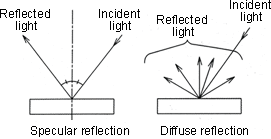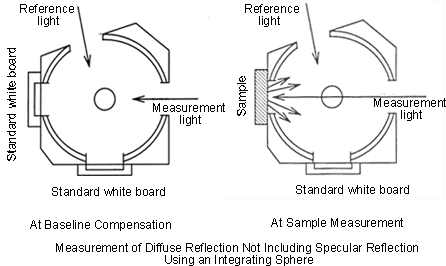Relative Diffuse Reflectance Measurement
Diffuse Reflectance Measurement

Since light cannot penetrate opaque (solid) samples, it is reflected on the surface of the samples. As shown in the figure, incident light reflected symmetrically with respect to the normal line is called "specular reflection," while incident light scattered in different directions is called "diffuse reflection."



With integrating spheres, measurement is performed by placing the sample in front of the incident light window, and concentrating the light reflected from the sample on the detector using a sphere with a barium sulfate-coated inside. The obtained value becomes the reflectance (relative reflectance) with respect to the reflectance of the reference standard white board, which is taken to be 100%.
When light is directed at the sample at an angle of 0°, specular reflected light exits the integrating sphere and is not detected. As a result, only diffuse reflected light is measured. Models of integrating spheres with different angles of incidence are available, enabling measurement of both specular and diffuse reflected light in instances such as these.
Downloads
Download the latest brochure.
Applications
News / Events
-
FTIR TALK LETTER Vol. 43 has been published
The article about the Introduction to the Spectrum Advisor can be used on all Shimadzu FTIR systems controlled by LabSolutions IR. Learn the key points of infrared spectral analysis for aliphatic unsaturated hydrocarbons and aromatics.
-
Analytical Solutions for Microplastics
Shimadzu provides analytical and measuring instruments for the study of a variety of plastic materials: for R&D, characteristic evaluation of raw materials, quality control for plastic products, and deterioration analysis. With these diverse techniques, Shimadzu provides optimal solutions for microplastics research.
-
Shimadzu has released the IRSpirit-X Series
IRSpirit FTIR spectrophotometers are extremely compact, but can still be used with standard accessories from Shimadzu and other manufacturers. IRSpirit instruments come with IR Pilot software, which offers 23 application programs without the need for parameter setup. Measure multiple samples with just a few clicks.
-
Shimadzu has released the MAP-100
The MAP-100 automates the typical steps needed to isolate microplastics. This improves the reproducibility of the analytical workflow, enables lab technicians to focus on other tasks, and makes handling of reagents safer.
-
Latest issue of Shimadzu Journal, featuring Forensics / Toxicology, has come out.
This issue focuses on "Forensics / Toxicology", an area where science and technology are particularly important and needed. It starts with two customer interviews.
-
Cellulose nanofibers
Given that cellulose nanofibers(CNFs)offer attractive physical characteristics, such as light weight, strength, and hardness, they not only enable materials with advanced functionality, but are expected to be used as a reinforcing material that can reduce the weight of composite materials.




